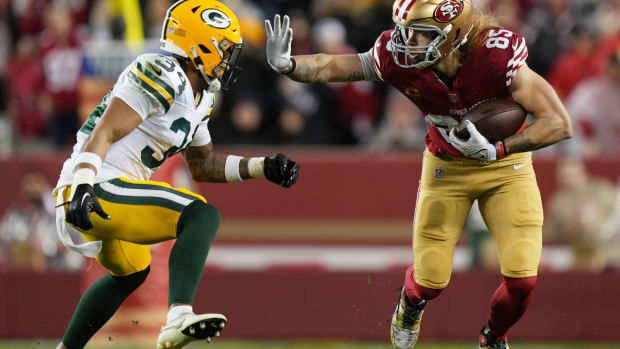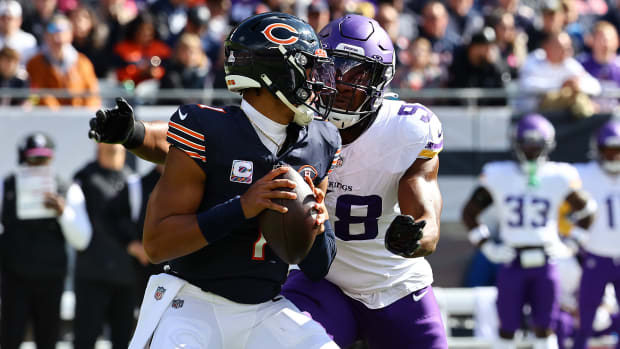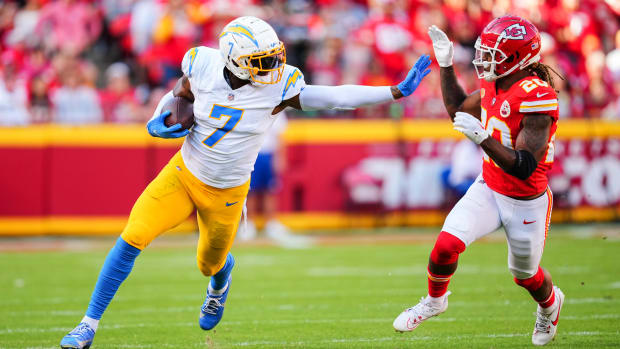Three Areas Bears Must Control Offensive Quality
Matt Nagy isn't big on history, at least regarding his own team.
"We don't care about 2018," Nagy told reporters as his offseason virtual program ended. "We are in such a good place right now as a team mentally, schematically, personally each guy wanting to be a little better and understanding that if they focus on themselves that we will be better. So I don't even like bringing it up because we're in such a good place."
Still, there is that whole George Santayana thing. He's the writer/philosopher who coined "Those who cannot remember the past are condemned to repeat it."
Not much good happened last season for the Bears on offense in their 8-8 season and as a result some heads on the coaching staff rolled, while tight end Trey Burton, wide receiver Taylor Gabriel and guard Kyle Long are no longer around.
The Bears have problems to solve on offense when training camp begins, and they would say they've already set about doing it through their Zoom classes.
There is a difference between reality on the field and the internet.
Here are the three critical issues the Bears need to set about fixing on offense when they take the practice field July 28, ranked in order of importance.
3. Red Zone Scoring
Nagy might call this the most important—solving it won't be possible unless they get at least one other issue solved first.
Nagy's comment from the end of the season still holds true about the red zone problems: "That's where you get your points. I don't want field goals, we don't want field goals. You have to score touchdown."
The Bears finished 24th in red zone scoring last year, dropping down 13 places.
They did address this personnel-wise with three new tight ends, all 6-foot-6 or taller. They can go vertical down close to a greater degree.
Did they address it at quarterback?
Mitchell Trubisky tied for the NFL lead in red zone interceptions thrown last year.
He was 20th last year and 16th in 2018 at touchdown passes thrown within the red zone. His completion percentage last year in the red zone was 28th among passers with at least 25 attempts at 50.8%.
Completion percentage isn't the most crucial statistic there. Getting it into the end zone is. Patrick Mahomes was only 26th in red zone completion percentage at 51.8 and threw only 11 TD passes in the red zone. What was important was Mahomes threw only one red zone interception, three less than Trubisky.
Whether Nick Foles is a big upgrade in this area is largely unknown. In 2017 he did rank in the top five in completion percentage within the red zone. He didn't have enough attempts the last few years to really know for certain.
Trubisky has never been very good at it. He threw only four touchdown passes in the red zone as a rookie in a different offense, with 12 starts.
They'll be working the red zone passing drills over and over, much like they always do.
They also have to get better running it inside the 10. Last year David Montgomery only had six touchdown runs and five came from inside the 6-yard line. But it took him 14 rushing attempts from down there to do it.
2. Better Yards Per Pass Attempt
Trubisky was so poor at this last year, it's probably the main reason they needed another quarterback.
He was last in the league among starters at 6.1 yards per attempt.
There aren't enough passes completed downfield, but there also are not enough pass plays caught for short yardage that get broken for longer gains. And the Bears have plenty of receivers capable of doing this.
They've been near or at the bottom of the league since Trubisky became quarterback at yards per pass attempt and yards after the catch.
Completing a few downfield or breaking a few long ones can work wonders.
It's a matter of recognizing defenses, knowing when and where to attack downfield.
Bringing in Foles doesn't completely solve this problem because he's only been known sporadically for getting the ball downfield. His career average is 7.0 and Trubisky's 6.7.
It doesn't have to be among the best in the league to win the division, although it definitely helps.
The Packers were only 16th at this last year at 6.7 and won the NFC North by pairing it with a strong defense and running game. When Trubisky reached 7.0 in 2018, the Bears ranked 14th as a team at yards per attempt.
It just can't be close to 6.0 or lower unless they want disaster again.
1. Consistent Rushing
In two seasons under Matt Nagy the Bears have totally neglected the running game, other than drafting David Montgomery.
They've watched as the Packers, Vikings and even the Lions all built better rushing attacks within the NFC North. All were better at running than the Bears last year.
If there's more for a defense to worry about on the ground, it can help solve the other two problems.
The ball gets downfield more in the passing game with defenses concerned about getting beat with the run. They also get into the end zone more in the red zone if they can run. So this is more important than both of the other two issues.
Montgomery hardly looks like the problem, even if he had only five runs of 15 yards or more as a rookie. He did show an ability to break away on very rare occasions when he had the blocking.
Coaches don't expect a problem from Montgomery's end.
"He seems to be to me a guy who really has his mindset on what he expects this year to be for him, and I'm excited about it," offensive coordinator Bill Lazor said.
The entire problem was dumped at the feet of new offensive line coach Juan Castillo to fix, and they gave him only converted guard Germain Ifedi as a new part to help fix it.
If Castillo can work miracles, and they can avoid getting 3.7 yard a carry again by posing a real threat in the running game, the passing game downfield can open up.
When Titans running back Derrick Henry began pummeling defenses, it opened up the secondary for Ryan Tannehill to get the ball downfield. A quarterback averaging 7.0 yards an attempt before last year then averaged a phenomenal 9.6 yards an attempt.
The two can go hand in hand, but the yards per pass are tough to achieve without one of the league's best passers and receiving corps unless a top running gameaccompanies it.
And it's safe to say the Bears do not possess one of the league's best passers or the best receiving corps.
Twitter: BearDigest@BearsOnMaven




